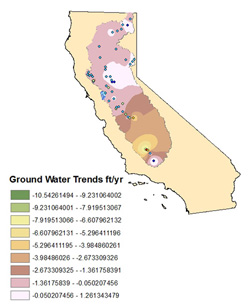News | February 23, 2009
GRACE Reveals Major Groundwater Loss in California's Heartland
New space observations reveal that since October 2003, the aquifers for California's primary agricultural region -- the Central Valley -- and its major mountain water source -- the Sierra Nevadas -- have lost nearly enough water combined to fill Lake Mead, America's largest reservoir. The findings, based on data from the NASA/German Aerospace Center Gravity Recovery and Climate Experiment (Grace), reflect California's extended drought and increased rates of groundwater being pumped for human uses, such as irrigation.

In research being presented this week at the American Geophysical Union meeting in San Francisco, scientists from NASA and the University of California, Irvine, detailed California's groundwater changes and outlined Grace-based research on other global aquifers. The twin Grace satellites monitor tiny month-to-month changes in Earth's gravity field primarily caused by the movement of water in Earth's land, ocean, ice and atmosphere reservoirs. Grace's ability to directly "weigh" changes in water content provides new insights into how Earth's water cycle may be changing.
Combined, California's Sacramento and San Joaquin drainage basins have shed more than 30 cubic kilometers of water since late 2003, said professor Jay Famiglietti of the University of California, Irvine. A cubic kilometer is about 264.2 billion gallons, enough to fill 400,000 Olympic-size pools. The bulk of the loss occurred in California's agricultural Central Valley. The Central Valley receives its irrigation from a combination of groundwater pumped from wells and surface water diverted from elsewhere.
"Grace data reveal groundwater in these basins is being pumped for irrigation at rates that are not sustainable if current trends continue," Famiglietti said. "This is leading to declining water tables, water shortages, decreasing crop sizes and continued land subsidence. The findings have major implications for the U.S. economy, as California's Central Valley is home to one sixth of all U.S. irrigated land, and the state leads the nation in agricultural production and exports."
"By providing data on large-scale groundwater depletion rates, Grace can help California water managers make informed decisions about allocating water resources," said Grace Project Scientist Michael Watkins of NASA's Jet Propulsion Laboratory, Pasadena, Calif., which manages the mission for NASA's Science Mission Directorate, Washington.
For the rest of this story click Here
JPL is managed for NASA by the California Institute of Technology in Pasadena.





